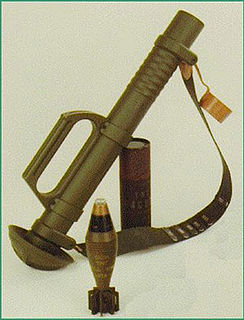 W
WThe term Commando mortar refers to a class of lightweight infantry mortars designed for maximum portability and rapid deployment, at the expense of accuracy and repeatability. Earliest models had been introduced from the 1930s onwards.
 W
WThe 2B9 Vasilek (Cornflower) is an automatic 82 mm gun-mortar developed in the Soviet Union in 1967 and fielded with the Soviet Army in 1970. It was based on the F-82 automatic mortar. Unlike conventional mortars, the 2B9 can fire in single and automatic mode using four-round clips. Rounds can be loaded from either the muzzle or the breech. Because of its wheeled carriage, the 2B9 resembles a light artillery piece more than a conventional mortar.
 W
WThe 2B11 is a 120 mm mortar developed by the Soviet Union in 1981 and subsequently fielded in the Soviet Army. The basic design for the 2B11 was taken from the classic Model 1943 120 mm mortar, and incorporated changes to make the mortar less heavy. Is a part of the 2S12 Sani.
 W
WThe 2B14 Podnos is a Soviet 82 mm mortar. The 2B14 was designed in early 1980s as a light indirect fire weapon for the use of airborne and other light infantry forces. Despite the intent to field the 2B14 with light infantry units, the 2B14 appears to have been fielded with regular motor rifle units as well at a scale of six per battalion.
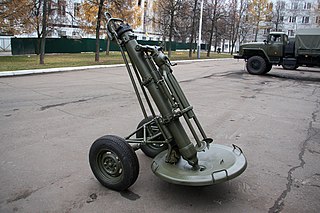 W
WThe 2S12 "Sani" ("sleigh") is a 120 mm heavy mortar system used by the Russian Army and other former Soviet states. First fielded in 1981, the 2S12 is a continued development on the towed mortars first used in World War II.
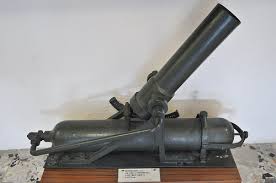 W
WThe 8 cm Luftminenwerfer M 15 was a light mortar used by Austria-Hungary in World War I. It was designed by the 58th Infantry Division and the first twenty were built in the division's workshops. Later production was contracted out to Vereinigte Elektrische Maschinen A. G. in Budapest. It used the breakable screw method to retain the bomb in place until the air pressure in the chamber was strong enough to break the screw. Grooves of different depths could be used to vary the range. It was sometimes referred to as the Roka-Halasz system.
 W
WThe 9 cm Minenwerfer M 14 was a light mortar used by Austria-Hungary in World War I. It was designed by the Army's own Technisches und Administratives Militär-Komitee (TMK) in an effort to quickly satisfy the demand from the front for a light mortar. It had a number of issues with its ammunition, namely the black powder used as a propellant gave off copious smoke clouds on firing that revealed the tube's location and the mortar bomb fuzes had a high rate of failure. The breech-loading mortar tube was mounted on a framework that didn't allow for any traverse, which meant that it was impossible to engage different targets without relaying the mortar. In turn the frame was mounted a rectangular firing platform.
 W
WThe 9 cm Minenwerfer M 17 was a medium mortar used by Austria-Hungary in World War I. It was developed by the Hungarian Gun Factory to meet a competition held on 3 October 1917 to replace both of the earlier light mortars, the M 14/16 and the Lanz. Production was slow to ramp up and only ten weapons could be delivered in January 1918. The first large deliveries were made in March 1918, but the raw materials crisis and strained production facilities hindered the TMK's plan to produce 2730 mortars by October 1918.
 W
WThe 9 cm mortar Type GR was a World War I Russian mortar, developed circa 1915. Its shell is comparable in power to the modern 81mm mortar shell.
 W
WThe 10.5 cm Luftminenwerfer M 15 was a medium mortar used by Austria-Hungary in World War I. It was developed by the German firm of Ehrhardt & Sehmer. It was a rigid-recoil, muzzle-loading mortar on a fixed base that used compressed air to propel the mortar bomb to the target. Each cylinder of compressed air lasted for fifteen shots. A notable advantage was that the mortar had no firing signature, unlike conventional mortars with smoke and muzzle flash.
 W
WThe 12 cm Minenwerfer M 15 was a medium mortar used by Austria-Hungary in World War I. It was designed by the Army's own Technisches und Administratives Militär-Komitee (TMK) as an enlarged 9 cm Minenwerfer M 14 in 1915. The War Ministry decided to order 50 from the TMK, but the latter preferred only to produce 10 and switch the remaining 40 to the 14 cm Minenwerfer M 15, but no response was made by the Ministry. The TMZ placed an order for the 10 mortars from Teudloff & Dittrich in Vienna at the end of 1915. A follow on order for another hundred was canceled in February 1916.
 W
W81 KRH 71 Y is a light mortar manufactured by Tampella for use by the Finnish Army. It is usually used to support the infantry by indirect fire, but it can also be used for direct fire. Each Finnish infantry company has a platoon of 81 mm mortars. The mortar platoon consists of three seven-man mortar squads, each squad manning a single 81 mm mortar. Jaeger Company M2005 has a fire support squad, which consists of two five-man mortar teams, both equipped with an 81 mm mortar. It can fire HE-fragmentation, smoke, illumination and practice rounds.
 W
WThe 120 KRH 92 is a 120 mm mortar manufactured in Finland.
 W
WThe Aasen mortar was a 3.5-inch (88.9-mm) gun-mortar. The Aasen was invented in France in 1915 by Nils Aasen, a Norwegian arms designer. It was adopted by the Russian Empire in 1915-1916, and was used during the First World War.
 W
WThe Brixia Model 35 was an Italian small-sized, rapid firing light mortar of World War II.
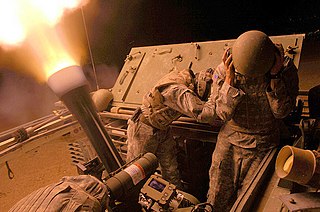 W
WThe Cardom "Hatchet", is an Israeli 81mm/120mm Recoil Mortar System (RMS), manufactured by Soltam Systems. It is used by the US Army, the Israel Defence Forces, NATO countries, and others. The Cardom is an autonomous, computerized system for mounting on light and medium armored carriers. The system provides accurate and effective fire support.
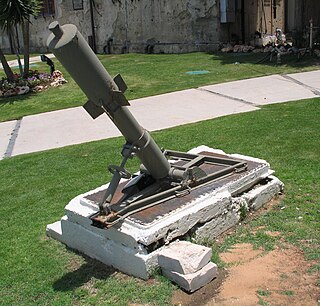 W
WThe Davidka was a homemade Israeli mortar used in Safed and Jerusalem during the early stages of the 1948 1947–1949 Palestine war. Its bombs were reported to be extremely loud, but very inaccurate and otherwise of little value beyond terrifying opponents; they proved particularly useful in scaring away both Arab soldiers and civilians. It is nominally classified as a 3-inch (76.2 mm) mortar, although the bomb was considerably larger.
 W
WThe Garland trench mortar was an improvised mortar used by Australian and British forces at Gallipoli during the Dardanelles Campaign of 1915–16. Developed early in the war by Herbert Garland, a pre-war metallurgist and superintendent of laboratories at the Cairo Citadel, it was the most numerous mortar of the Gallipoli Campaign. A simple, improvised design, the Garland mortar consisted of a smoothbore steel barrel fixed at 45 degrees to a solid wooden base. By means of a powder charge it propelled a variant of the jam tin grenade. Its design meant that the whole weapon had to be turned to change its traverse and raised on a box to increase its range but despite these limitations it was reported to have done "good work" in the front line.
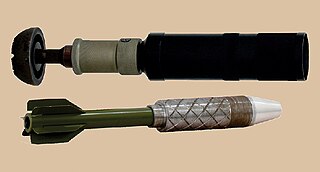 W
WThe GNM-60 is a 60mm noise reduced mortar designed for special forces and tactical groups for concealed operations. It allows troops to fire while maintaining concealment. The weapon can be operated by a single individual. The mortar is made by STC Delta.
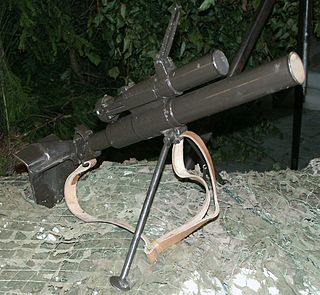 W
WThe Granatnik wz.36 was a Polish grenade launcher designed in originally in 1927 as "wz. 30" and later modified in 1936. It entered service in 1936 becoming the standard grenade launcher of the Polish Army; it was still in use during the German Invasion of Poland in 1939.
 W
WThe Hirtenberger M6C-210 is a light mortar with smoothbore barrel, part of the M6 mortar range designed by Hirtenberger Defense Systems of Austria.
 W
WThe United Kingdom's L16 81mm mortar is the standard mortar used by the British armed forces. It originated as a joint design by the UK and Canada. The version produced and used by Australia is named the F2 81mm Mortar, whilst the version used by the U.S. armed forces is known as the M252.
 W
WThe LGI Mle F1 is a French close-support weapon infantry weapon designed to be used by one man, which provides soldiers with a lightweight indirect-fire support weapon similar to a small mortar. In many ways, it is a modernized version of the Type 89 grenade discharger used by the Japanese Army during World War II. The LGI has been used by the Foreign Legion and other French Army forces since the 1990s.
 W
WThe Mortier de 81mm léger long renforcé is a mortar used by the French Army, manufactured by Thales. Introduced in 1997, it is the latest iteration of the TDA 81 mm light mortar family.
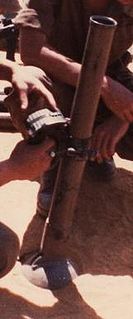 W
WThe M-4 Commando Mortar also known as a "patrol mortar" is a lightweight 60 mm commando mortar manufactured by Denel Land Systems.
 W
WThe M1 mortar is an American 81 millimeter caliber mortar. It was based on the French Brandt mortar. The M1 mortar was used from World War II until the 1950s when it was replaced by the lighter and longer ranged M29 mortar.
 W
WThe M2 4.2-inch mortar was a U.S. rifled 4.2-inch (107 mm) mortar used during the Second World War and the Korean War. It entered service in 1943. It was nicknamed the "Goon Gun" or the "Four-Deuce". In 1951 it began to be phased out in favor of the M30 mortar of the same caliber.
 W
WThe M2 Mortar is a 60 millimeter smoothbore, muzzle-loading, high-angle-of-fire weapon used by U.S. forces in World War II, the Korean War, and the Vietnam War for light infantry support.
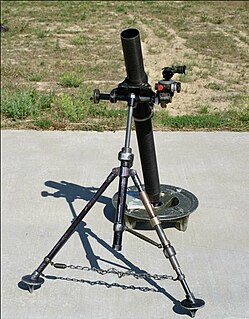 W
WThe M29 is an American-produced 81 millimeter mortar. It began replacing the M1 mortar in U.S. service in 1952 being lighter and with greater range. It was subsequently replaced by the M252 mortar in 1987. Variants included the M29E1 and M29A1, adopted in 1964. These were produced with a hard chrome-plated bore to prolong barrel life and ease of cleaning.
 W
WThe M30 106.7 mm heavy mortar is an American rifled, muzzle-loading, high-angle-of-fire weapon used for long-range indirect fire support to infantry units.
 W
WThe M75 mortar is designed by Military Technical Institute Belgrade in Yugoslavia. It is smooth bore, muzzle-loading, high-angle-of-fire weapon used for long-range indirect fire support. Today they are produced by Serbian company PPT-Namenska AD and BNT from Bosnia and Herzegovina.
 W
WThe M224 60 mm Lightweight Mortar is a smooth bore, muzzle-loading, high-angle-of-fire weapon used for close-in support of ground troops. It was deployed extensively in the War in Afghanistan by the United States.
 W
WThe M252 81 mm medium weight mortar is a British designed smooth bore, muzzle-loading, high-angle-of-fire weapon used for long-range indirect fire support to light infantry, air assault, and airborne units across the entire front of a battalion zone of influence. In the U.S. Army and U.S. Marine Corps, it is normally deployed in the mortar platoon of an infantry battalion.
 W
WThe 120-PM-38 or M1938 was a 120 mm Soviet mortar that was used in large numbers by the Red Army during World War II. Although a conventional design its combination of light weight, mobility, heavy firepower and range saw its features widely copied by successive generations of mortars.
 W
WThe Yugoslavian 60mm M57 Mortar was generally based on the design of the US 60mm M2 Mortar. Currently, the M57 Mortar is produced by the Serbian company PPT-Namenska AD, and is still used in the Special Brigade of the Serbian army.
 W
WThe Soltam K6 is a 120 mm mortar that was developed by Soltam Systems of Israel. It is the long-range version of the Soltam K5 and has replaced older systems, such as the 107-millimetre (4.2 in) M30, in several armies including the United States Army. It is much lighter than the M30, has a greater range, and can sustain a rate of fire of four rounds per minute, while the M30 could sustain only three.
 W
WThe Stokes mortar was a British trench mortar designed by Sir Wilfred Stokes KBE that was issued to the British and U.S. armies, as well as the Portuguese Expeditionary Corps, during the later half of the First World War. The 3-inch trench mortar is a smooth-bore, muzzle-loading weapon for high angles of fire. Although it is called a 3-inch mortar, its bore is actually 3.2 inches or 81 mm.